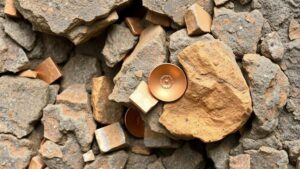Spotting Exposed Ore Veins in Eroded Rock Faces and Cliffs
Spotting Exposed Ore Veins in Eroded Rock Faces and Cliffs
Exposed ore veins present valuable opportunities for geologists and mineral explorers seeking to locate and extract commercially viable minerals. These veins, often discovered in eroded rock faces and cliffs, can provide insights into the geological history of an area, the types of minerals present, and potential extraction methods. This article delves into the identification, formation, and significance of exposed ore veins, enhancing the understanding of this critical geological phenomenon.
Understanding Ore Veins
Ore veins are concentrated deposits of minerals that have crystallized in fractures or cavities within rock. are often rich in metals such as gold, silver, copper, and lead, making them prime targets for mining operations. The formation of ore veins is frequently associated with hydrothermal processes, where mineral-rich fluids are heated and forced through rock formations, depositing minerals as they cool.
Formation of Ore Veins
The geological processes that lead to the formation of ore veins can be complex and variable. Typically, the following steps outline this process:
- Hydrothermal Activity: Heated fluids move through rock fractures, carrying dissolved minerals.
- Cooling and Deposition: As the fluids cool or lose pressure, minerals crystallize and precipitate out of solution.
- Erosion: Over time, erosion can wear away the surrounding rock, exposing these vein minerals on cliff faces.
An example of this can be seen in the Sierra Nevada mountains, where quartz veins rich in gold can be spotted in eroded rock faces, often revealing their presence through distinctive color variations and textures.
Identifying Exposed Ore Veins
Spotting exposed ore veins requires a keen eye and understanding of geological indicators. Here are some key factors to consider:
Visual Characteristics
Ore veins can often be identified by their distinctive colors and textures. Common examples include:
- Color: Gold-bearing quartz may appear white or milky with golden flecks.
- Texture: A vein may exhibit a banded texture, showcasing alternating layers of minerals.
Tool Usage
Using tools such as hand lenses or portable spectrometers can help further identify the mineral composition of a vein. For example, geologists often utilize X-ray fluorescence (XRF) analyzers to determine the elemental composition of exposed minerals rapidly.
Location and Context
Many ore veins can be found in specific geological settings. Common locations include:
- Near Fault Lines: Fractures in the earths crust create pathways for mineral-rich fluids.
- In Volcanic Areas: Hot springs and volcanic activity can lead to mineral deposition.
For example, the Mesabi Iron Range in Minnesota is known for its significant iron deposits, as geological processes associated with ancient volcanic activity contributed to the formation and exposure of ore veins in the region.
Significance of Exposed Ore Veins
The study of exposed ore veins is crucial in geology and mineralogy, providing insights that can influence mining practices, environmental considerations, and economic implications. Key points to explore include:
Economic Value
Exposed ore veins often represent economically extractable resources. For example, the discovery of exposed silver veins in Mexico has historically led to significant mining operations, driving local economies and sometimes even national industries.
Environmental Considerations
Mining activities based on exposed ore veins can have profound environmental impacts. It is crucial for geologists and environmental scientists to assess these impacts carefully and develop responsible mining practices that mitigate harm to surrounding ecosystems.
Actionable Takeaways
For those interested in or involved with mineral exploration, understanding how to identify and analyze exposed ore veins can be immensely beneficial. Key takeaways include:
- Familiarize yourself with the signs of ore veins, including their visual characteristics.
- Use modern tools like XRF analyzers to confirm the presence of minerals.
- Study local geological formations to understand where ore veins are likely to be found.
To wrap up, spotting exposed ore veins in eroded rock faces and cliffs is not merely a matter of chance; it requires knowledge, skill, and an understanding of geological processes. With continued exploration and responsible practices, these veins continue to offer insights not only for the mining industry but for our collective understanding of the Earth’s geological history.


